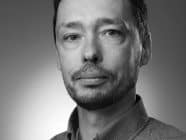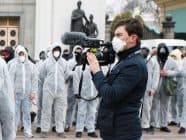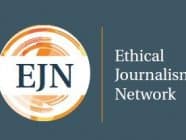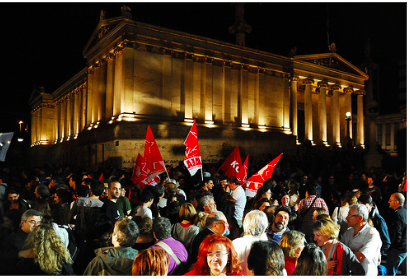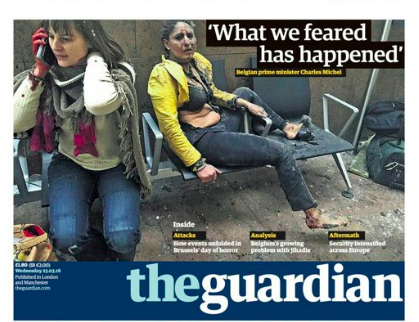 A woman sits wounded and dazed, her shirt blown off. Another beside her, also injured, phones for help. It is minutes after two massive suicide bomb explosions at Brussels airport and the soon-to-be iconic image is taken by a Georgian journalist, Ketevan Kardav. Later, many ask if she should have put her camera down and helped the victims instead of photographing them.
A woman sits wounded and dazed, her shirt blown off. Another beside her, also injured, phones for help. It is minutes after two massive suicide bomb explosions at Brussels airport and the soon-to-be iconic image is taken by a Georgian journalist, Ketevan Kardav. Later, many ask if she should have put her camera down and helped the victims instead of photographing them.
“I don’t know how I did it. I don’t know how I took that photo. As a journalist, it was my instinct,” Kardav said later. “In that very moment, I realised that to show the world what was happening in this moment of terror, a photo was more important.”
It’s the same dilemma faced in 1993 by a South African photographer, Kevin Carter, who won the Pulitzer prize for his disturbing photograph of a starving Sudanese child being stalked by a vulture. It’s not known what happened to the child, but a year later, Carter committed suicide.
Hanging over all such images of distress is the question of whether journalists should intervene, or simply record what they see. What are the borderlines of this moral and ethical dilemma, and who – if anybody – should be in charge of them?
Can photojournalists ever be objective?
The debate about how detached professionals should be is linked to another serious problem: can the photo-reporter ever achieve objectivity when they are, in effect, the middleman deciding on what visual information is given to the viewer?
Photographs can be accepted as evidence of something “that-has-been” – in the words of the philosopher Roland Barthes, who looked at the role of emotion and subjectivity in photography – a way of “making permanent the truth”.
However, the action of freezing a moment in time depends on the personality, point of view and decision-making of the photojournalist who offers a kind of partial, or cropped, reality.
The impact of digital technology on ethics in photojournalism
The digital revolution has itself complicated credibility and authenticity. Digital technology enables alterations to be made almost as effortlessly as pressing the shutter button. Any element of a photograph can be improved, modified or added to. Worse, manipulation of digital images is almost impossible to detect.
A recent study into photojournalists currently working in Central Europe (the Czech Republic, Poland and Slovakia), revealed that photojournalists have a strong sense of professionalism and ethical awareness.
The study, conducted by researchers from the Institute of Communication Studies and Journalism at Charles University in Prague, found that decisions taken by photojournalists always depended on the context, and the evaluation of each case independently. Thus even the most questionable practice might be acceptable under certain conditions.
Ethically ambiguous practices could include staging of photographs; paying for an exclusive, for information or access; and taking and publishing pictures of somebody who had refused to be photographed. Photojournalists interviewed for the study often make a distinction between hard news and soft coverage such as lifestyle, feature and illustration photography.
Alteration and manipulation was tolerated least in the case of hard news.
Ethical concern is also expressed over the depiction of crises and human suffering. Deciding whether to take the picture of a dramatic event or ‘save’ the victim is a moral, humanistic and legal issue. Again, photojournalists claim that every situation requires careful consideration, but agree there are certain limits when newsworthiness should not take precedence over an obligation to provide first aid.
The majority of those questioned did not approve of taking or publishing any kind of graphic imagery or photographs of children taken without parental consent. In other cases, like disturbing images of disasters, victims, violence and nudity, the respondents expressed quite a high level of responsibility in their answers. They appeared conservative in the debate on media ‘tabloidisation’ and so- called ‘info-tainment’.
Photos should not be digitally altered, except in certain conditions
Our study found that all photographs published in news media today are edited using digital imaging software. Some changes are considered to be common practice, such as colour enhancement, colour balance, contrast, cropping etc.
Other alterations are accepted by photo editors and journalists only under specific conditions. The majority of respondents did not approve any digital image editing other than what is common practice and does not change the overall meaning of the photograph. A minority opposed even those changes, especially cropping.
On the other hand, they were more relaxed about the digital alteration of soft and illustration content, from the level of simple re-touching up to photomontage. Several respondents said they had no problem with any alteration as long as the caption ‘photo illustration’ appeared next to the image. In other words, manipulation is possible for anything as long as the recipient is aware of it.
Central European photojournalists tend to set their own standards and ethical codes according to the needs of their newsroom, rather than submit to explicit regulation and enforcement by an official organisation. Indeed, they struggle with the implementation of such standards.
Because of the region’s history, there is a natural distrust of professional associations, unions and other similar organisations, which were misused by totalitarian regimes during the second part of the twentieth century. This might explain why few photojournalists are members of any journalistic professional body. Nor are there any active organisations aimed at photojournalists, such as the NPPA ( National Press Photographers Association) in the United States.
Nevertheless, future debate should include whether to form functional professional associations dedicated to visual content, which would contribute to the development of photojournalism in the region, improve its culture and draw up a Code of Ethics.
Roland Barthes, Camera Lucida, Reflections on Photography, is available as a PDF
Pic credit: screenshot from Guardian front page, March 23, 2016
Tags: Brussels attacks, brussels bombing, Camera Lucida, Charles University Prague, Czech Republic, digital news, ethics, NPPA, Photojournalism, Poland, Research, Roland Barthes, Slovakia



